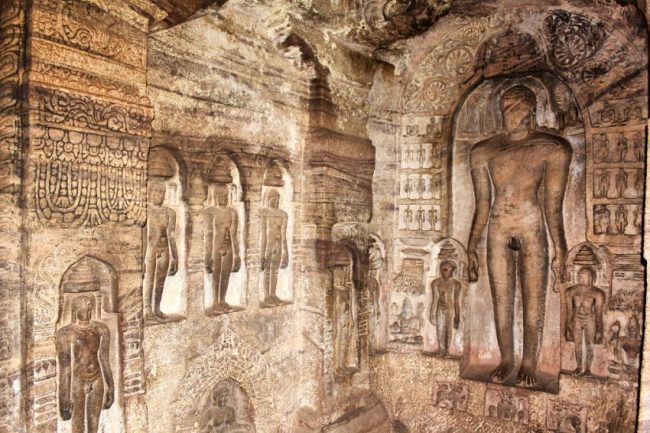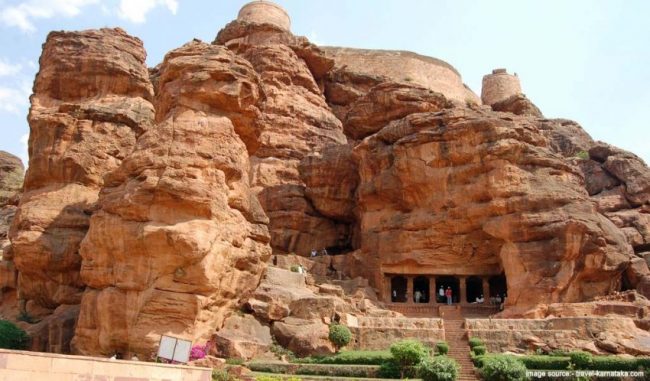Badami Cave Temples
Table of Contents
Badami Cave Temples, situated in the Bagalkot area of North Karnataka, was the capital of the Chalukya Dynasty. It is arranged at the mouth of a lovely gorge, flanked on either side by excellent sandstone slopes.
The First leader of the Early Chalukya tradition, Pulakesi I set up another capital for his kingdom at some point around 540 AD. This city was situated at the mouth of soak gorge and at first was named Vatapi. These days it is known as Badami.
Awesome kingdom required extraordinary asylums. Badami Chalukyas fabricated Badami Cave Temples – the absolute most wonderful Indian shake cut temples.
Badami is truly famous for its Cave Temples that date back to the 6th and 7th centuries. Located at Badami in Bagalkot district of Karnataka, Badami Cave Temples represent the fine architectural style of the ancient times.
The nearest airport to Badami is located in Belgaum. Belgaum lies at a distance of 150 kms from Badami and one can easily reach the cave temples by hiring taxis.
Various tourist buses and coaches are also available throughout the state of Karnataka. Badami is sited at the orifice of a gorge that is fringed by two rocky hills.
Chalukyan illustrious Badami Cave temples
The water spilling out of the gorge in Badami is accumulated in an antiquated manufactured lake – Agastya tirtha store.
High over the water there are towering bluffs of similarly delicate sandstone. Illustrious altars were made in these precipices with excellent view opening over the previous capital city.
The four Badami Cave temples were built by the child of Pulakesi I – Kirthivarman (controlled in 567 – 598 AD) and his sibling Mangalesha I (administered in 598 – 610 AD).
One give in is dedicated to Shiva, two – to Vishnu. Fourth give in is Jain temple. Therefore Chalukyas, much the same as a few other fruitful lines of Ancient India, showed religious resilience.
Despite the fact that in numerous regards these structures rehash the engineering of comparable Indian give in temples made some time recently, there is detectable additionally an improvement of particular style in design and workmanship – Chalukyan style.
Specialty of Badami shows impact both of South Indian styles (Dravidian style) and northern impacts (Indo-Aryan Nagara style).
Badami Cave Temples have basic outside however their insides have exceptionally lavish wrapping up. Spellbind leads through a pillared verandah – mukha mandapa, columns have square frame in area. Three hollows are decorated with a luxurious frieze underneath the segments.
The fundamental lobby of every temple – maha mandapa – is remaining on huge segments. Farthest part of the temple behind the primary lobby is the hallowed place – cella or garbhagrha.
In all probability surrenders were secured with energizing wall paintings – just hints of this previous excellence remain.
Vital component of Badami Cave temples and their surroundings is old engravings in Kannada composing and in Kannada and Sanskrit dialects. Altogether in Badami there have been discovered 18 precipice engravings. The most established is from 543 AD.

A standout amongst the most critical engravings is made in 700 AD at the upper east end of supply. It comprises of ten lines in Kannada composing, both in Kannada and Sanskrit dialects.
This engraving is not totally obviously interpreted but rather plainly it goes about Kappe Arahatta, neighborhood holy person and heroe. Under the engraving there is decent cutting of ten leaved lotus in circle.
There exists additionally the fifth collapse Badami – regular give in utilized as a Buddhist temple. It can be entered just on all fours. Territory contains additionally numerous different temples.

Badami Cave Temples 1
This Cave in all probability is the most seasoned – worked in 575 – 585 AD.
Spellbind gateway can be come to by 40 stages and contains four detached square segments and two semi-segments. Underneath the segments there is a frieze with ganas – chaperons of Shiva.
Fundamental lobby contains columns and a square molded holy place at the back divider. Roof is decorated with paintings of desirous couples wonderfully protected for over 1,400 years.
Rock is embellished with wonderful reliefs, the most amazing ones incorporate a gathering with Shiva and Parvati with a looped serpent and in addition remarkable landmark of workmanship – 18 outfitted Nataraja, which, when firmly watched, strikes 81 moving stances.
Badami Cave temples 2
Made in the late sixth century AD and committed to Vishnu who is appeared here as Trivikrama – with one foot on Earth and another – coordinated toward the north. Vishnu in this temple is spoken to likewise as Varaha (pig) and Krishna symbols.
Buckle is come to by climbing 64 stages from the principal give in. Passage is decorated with reliefs of watchmen (dvarapalas) with littler female specialists appeared.
Badami Cave Temples 3
The biggest and most famous surrender temple in Badami no doubt is made in 578 – 580 AD. Give in contains engraving by later Chalukya lord Mangalesa in Kannada – he sorted out removal of this Vaishnava temple. Engraving has been made in 578 AD, Mangalesa turned into a ruler in 597 and ruled until 609 AD. It is basic that Indian buckle temples were belittled by persuasive individuals from illustrious families.
Rock cut temple has north – south introduction. Principle corridor together with verandah goes up to 14.5 m profound into the mountain, sanctum makes the buckle for around 4 m more profound. Stature of the fundamental corridor is roughly 4.5 m.
Give in is come to by climbing 60 stages from the Cave 2. Veneer of the temple is around 21 m wide and is enhanced with a line of six monstrous segments. Beneath the sections there is a friese comprising of 30 littler reliefs of ganas.
Entire surrender is secured with sublime embellishments, including artistic creations on roof. Centerpiece of these paintings is four-equipped Brahma on his swan. On the floor beneath the painting of Brahma there is a lotus emblem – put where offerings were laid.
Huge landmarks of Indian workmanship are the various reliefs of Vishnu including standing Vishnu, Vishnu with a serpent, Vishnu as Narasimha (half human – half lion), Varaha, Harihara and Trivikrama symbols. Reliefs are 4 m high.
Workmanship in surrender 3 gives vital data about the way of life and garments in this area in the sixth century.

Badami Cave temples 4
This is the main Jain temple in complex and the most up to date collapse perplexing, made in the late sixth century – seventh century AD. It is found higher than different hollows. In the event that contrasted with the three past caverns, this buckle is less detailed and littler – yet at the same time lovely and rich with embellishment.
It contains cutting of the Tirthankara Parshavnatha with a serpent at his feet. Here is found additionally figure of Jain holy person Mahavira in situated posture (regularly mixed up for Buddha) and standing Gomatesvara with creepers curved around his legs.
Badami was before known by the name Vatapi. It is trusted that this name is identified with the legend of the evil presence Vatapi, which is connected with Sage Agastya. As per another story, Badami got its name from the Badam (Almond) shade of the sandstone of this place.
Badami was established by a before leader of the Chalukya Dynasty, King Pulakeshi around 540 AD. Later, it fell under the control of Pallavas, Rashtrakutas, Hoysalas, Vijayanagara Rayas, Adil Shahis, Savanur Nawabs, Marathas, Hyder Ali, and the British. Badami was incorporated under Bombay Presidency amid the British Raj.
The Tourist Attractions at Badami Cave temples
The old town of Badami is popular for its temples. The most noticeable among the temples of Badami are the sandstone give in temples.
The stone cut give in temples of Badami were developed in the middle of sixth and eighth hundreds of years by the Chalukyas Kirthivarman and Mangalesha I. These surrender temples are devoted to the gods of Hinduism and Jainism.
Out of the four buckle temples, one is devoted to Lord Shiva; two are committed to Lord Vishnu, and another to the Jain Tirthankaras. These temples are noted for the early style of South Indian style of temple engineering. The dividers of these give in temples likewise have engravings that go back to sixth and eighth hundreds of years.
Rock Climbing in Badami
Badami is a well known enterprise goal in the condition of Karnataka, inferable from the nearness of red sand stone bluffs that encompass the Agastya Tirtha water supply. These sandstone precipices have even breaks, which make Badami a favored goal of shake climbers.
Rock climbers going to Badami can go with the expectation of complimentary climbing (Trad and Sport Climbing) and bouldering.
Badami rocks have numerous various courses and more than 150 shot courses. Courageous shake climbers, including learners and experts, can appreciate shake moving at Badami.
The straightforwardness in shake moving at the sand stone bluffs of Badami has earned it the title ‘the Mecca of Rock Climbing‘ among neighborhood and also worldwide shake climbing lovers.
How to Reach Badami Cave temples
By Air:
The Nearest airports to Badami are Hubli (around 106 km) and Belgaum(around 150 km).These airports have connectivity to Bangalore and Mumbai. From Hubli and Belgaum we can reach Badami by taxi OR by bus.
By Train:
The ‘Badami Railway Station’ is around 5 km from the Badami Bus stand. We can reach badami through rail connectivity from Bangalore,Hubli,Bijapur,Gadag,and Solapur and from other cities.
The nearest major rail junction is hubli.The Hubli Jn has good rail connectivity with major cities across india.Also direct train is there from Bangalore (Yashawantapura Jn) to Badami.
By Road:
Badami is well connected by road. We can reach badami through road connectivity from Hubli, Dharwad, Belgaum, Bangalore, Bagalkot, Hampi, Bijapur, and from many other cities.
Also there are a good number of Govt and Private buses from Bangalore, Hubli, Belgaum and Bijapur.
Tonga’s- Horse-Cart is another mode of local transport easily available in the city and auto rickshaws’ as well.
Distance From Various Places To Badami
From Few Major Cities:
Distance from Pune To Badami is : 470 km.
Distance from Bangalore To Badami is : 464 km.
Distance from Hyderabad To Badami is : 420 km.